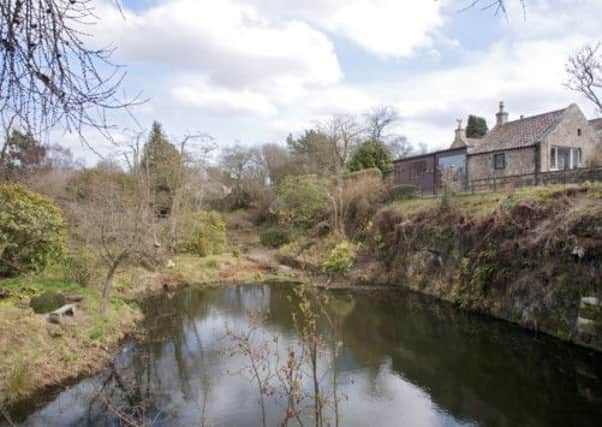Gardening runs from weeding and pruning to abseiling


IMAGES of pruning, raking and weeding come to mind when Julia Young says that now spring is finally on its way she can at last start work in her garden.
The reality is quite different. What Julia means only becomes obvious a short way into a tour of the undulating four-acre garden she shares with her husband George, a potter, at South Flisk, in the remote countryside west of St Andrews. While George creates exquisite, richly-glazed pots in his workshop a stone’s throw from the house, his wife might be abseiling down a 20ft steep hillside that flanks a deep former quarry.
Advertisement
Hide AdAdvertisement
Hide Ad“It’s the only way to weed the cliff face,” Julia says, matter of factly. “I tie the rope to my waist and then to the fence before letting myself down, weeding as I go.” And yes, she has fallen in to the black, inky water twice this year. Once when “tugging away at a handful of weeds from the boat I fell over backwards when they came away faster than I thought”. Another near miss happened when abseiling down the cliff and she felt the rope tighten round her waist. “I stopped being able to breathe, but don’t tell George about that time.”
George and Julia came to this converted smithy in the village of Blebo Craigs 17 years ago. The smithy, Julia explains, was used to shoe the ponies, which dragged the stone from the local quarries. The quarry now forms the major section of this two-part garden.
In front of the south-facing house a semi-formal area was enclosed by parallel walls and a hedge. To the rear, the quarry garden had become overgrown with Rhododendron ponticum “so thick only a dog could get into it,” and bamboo. Other overgrown varieties responded only to a chainsaw, revealing traces of stone steps and old paths. Only the remains of some trees and shrubs planted by a former owner, a Miss Ketelbey, who worked at St Andrews University, testify to a skilled planting scheme.
These included mature copper beech, Nothofagus and conifers such as a magnificent Scot’s pine, a noble fir and some larch. A well-established Rhododendron Arizelum ‘Falconera’ with spectacular brown stems and elegant foliage, also bears testimony to knowledgeable planting.
To the rear of the house, the path leads above the main quarry and down the first flight of stone steps, kept in immaculate order with George’s latest toy, a power washer.
In the first glen Julia explains that the garden evolved with no particular plan. “The shape of the land, with its water-filled quarries, dictated the planting,” she says, and the free-draining soil played its part in the choice of plants. Wind-blown trees created planting opportunities while scattered boulders and exposed rock face provided a guide for path layout.
With so much water in evidence it is surprising to learn that there is only one small area in which bog plants can be grown: close to the main quarry, below a generous patch of red-leaved Bergenia Cordifolia ‘Pupurea’. The remainder of the garden relies on leaf mould for moisture retention and nourishment.
This is particularly evident in the woodland bed sited at the foot of the south-facing bank as it rises out of the glen. Here, set in a rich bed of leaf mould, are a range of woodland plants such as jewel-coloured cyclamen coum, pools of blue pulmonaria and pale pink primroses.
Advertisement
Hide AdAdvertisement
Hide AdCheerful pink, yellow and cream hellebores add a joyous note, and precious trillium are about to unfurl. Among the early, wild, pale daffodils are signs of camassia and later meconopsis will take centre stage. In May carpets of bluebells spread throughout the garden.
More steps lead up the slope to a terrace with northerly views as far as Glenshee and Schiehallion, and from there down, past further smaller quarries, to the wilder part of the garden.
Explaining that she is not patient enough for propagation, Julia says she prefers to expand her plants by division. Rising early in the summer she spends all day in the garden, weeding and tidying, but avoiding grass cutting where possible.
In addition to the work of the garden that Julia has found increasingly absorbing since she retired five years ago, she enjoys the people she meets. A member of the Fife Committee for Scotland’s Gardens, she “loves talking about gardening and learning from other people”.
The abundance of water and the cover makes this garden a haven for wildlife, such as birds and different insects. Some wildlife though, is less welcome. When asked about her plans for this year, Julia replies that her main aim is to persuade the rabbits, deer and moles to relocate. It seems reinforcements for the couple’s Jack Russell terrier, Murphy, are urgently required. k
• South Flisk, Blebo Craigs, KY15 5UQ is open for Fife Garden Trail on 2, 9, 30 May and 6, 13 June from 3pm-7pm.
• Blebo Craigs is six miles west of St Andrews off the B939 between Strathkinness and Pitscottie. There is a small stone bus shelter opposite the road into the village and a small sign saying Blebo Craigs. There will be signs to South Flisk
• St Andrews Pottery (www.standrewspottery.co.uk)
• Julia buys most of her woodland and shade loving plants from Kirkcudbright based Buckland Plants (www.bucklandplants.co.uk)